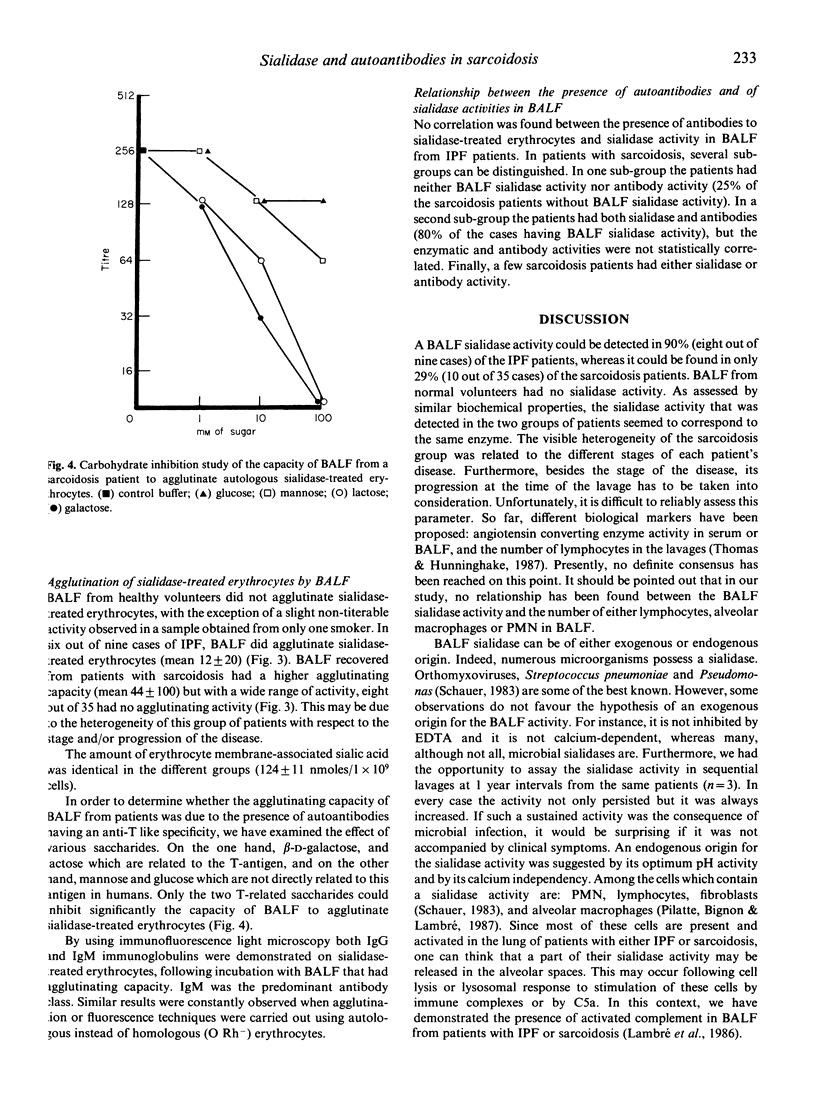Abstract
Sialidases catalyse the hydrolysis of terminal sialic acid of the carbohydrate moiety of glycoconjugates. Sialic acids play a key role in the expression or masking of antigenic sites and in cell-cell interactions. As an example, removal of sialic acid from the human erythrocyte membrane unmasks underlying molecules such as the specific carbohydrates (Gal-GalNac) of the so-called T or Thomsen-Friedenreich cryptic antigen. A consequence of this, is the recognition of that antigen by natural serum antibodies. Since the T antigen has been shown to be present in the lung, we have investigated the possible presence of sialidase and of specific antibodies to sialidase-treated cells in bronchoalveolar lavage fluids (BALF) from patients with pulmonary sarcoidosis or idiopathic pulmonary fibrosis (IPF). By using a fluorogenic substrate (4-methyl umbelliferyl-alpha-D-N-acetyl sodium neuraminate), we were able to detect a sialidase activity in BALF from eight out of nine patients with IPF and from ten out of thirty-five patients with sarcoidosis. BALF from normal volunteers and serum from both patients and normal volunteers were devoid of activity. BALF sialidase has an optimum pH activity of 5.4, it is not inhibited by EDTA and has a molecular weight close to 21 kD. BALF anti-T antibodies (galactose specific) were detectable in minute amounts in only one out of the nine normal volunteers. By contrast, they were frequently present in BALF from sarcoidosis (77%) or IPF (66%) patients and sarcoidosis patients had a higher mean activity. No correlation was observed between the enzymatic and antibody activities.
Full text
PDF





Selected References
These references are in PubMed. This may not be the complete list of references from this article.
- Akasaki M., Jardieu P., Ishizaka K. Immunosuppressive effects of glycosylation inhibiting factor on the IgE and IgG antibody response. J Immunol. 1986 May 1;136(9):3172–3179. [PubMed] [Google Scholar]
- Berrih S., Boussuges C., Binet J. P., Bach J. F. Studies on human thymocytes using anti-T-cell monoclonal antibodies and peanut agglutinin. Cell Immunol. 1982 Dec;74(2):260–268. doi: 10.1016/0008-8749(82)90026-0. [DOI] [PubMed] [Google Scholar]
- Bradford M. M. A rapid and sensitive method for the quantitation of microgram quantities of protein utilizing the principle of protein-dye binding. Anal Biochem. 1976 May 7;72:248–254. doi: 10.1006/abio.1976.9999. [DOI] [PubMed] [Google Scholar]
- Bray J., Lemieux R. U., McPherson T. A. Use of a synthetic hapten in the demonstration of the Thomsen-Friedenreich (T) antigen on neuraminidase-treated human red blood cells and lymphocytes. J Immunol. 1981 May;126(5):1966–1969. [PubMed] [Google Scholar]
- Crystal R. G., Bitterman P. B., Rennard S. I., Hance A. J., Keogh B. A. Interstitial lung diseases of unknown cause. Disorders characterized by chronic inflammation of the lower respiratory tract (first of two parts). N Engl J Med. 1984 Jan 19;310(3):154–166. doi: 10.1056/NEJM198401193100304. [DOI] [PubMed] [Google Scholar]
- Faraggiana T., Villari D., Jagirdar J., Patil J. Expression of sialic acid on the alveolar surface of adult and fetal human lungs. J Histochem Cytochem. 1986 Jun;34(6):811–816. doi: 10.1177/34.6.2422255. [DOI] [PubMed] [Google Scholar]
- Frohman M., Cowing C. Presentation of antigen by B cells: functional dependence on radiation dose, interleukins, cellular activation, and differential glycosylation. J Immunol. 1985 Apr;134(4):2269–2275. [PubMed] [Google Scholar]
- Kolb-Bachofen V., Kolb H. Autoimmune reactions against liver cells by syngeneic neuraminidase-treated lymphocytes. J Immunol. 1979 Dec;123(6):2830–2834. [PubMed] [Google Scholar]
- Lambré C. R., Kazatchkine M. D., Maillet F., Thibon M. Guinea pig erythrocytes, after their contact with influenza virus, acquire the ability to activate the human alternative complement pathway through virus-induced desialation of the cells. J Immunol. 1982 Feb;128(2):629–634. [PubMed] [Google Scholar]
- Lambré C. R., le Maho S., di Bella G., de Cremoux H., Atassi K., Bignon J. Bronchoalveolar lavage fluid and serum complement activity in pulmonary sarcoidosis. Am Rev Respir Dis. 1986 Aug;134(2):238–242. doi: 10.1164/arrd.1986.134.2.238. [DOI] [PubMed] [Google Scholar]
- Landolfi N. F., Cook R. G. Activated T-lymphocytes express class I molecules which are hyposialylated compared to other lymphocyte populations. Mol Immunol. 1986 Mar;23(3):297–309. doi: 10.1016/0161-5890(86)90057-x. [DOI] [PubMed] [Google Scholar]
- Miller V. E., Lagarde A. E., Longenecker B. M., Greenberg A. H. A phenyl-beta-galactoside-specific monoclonal antibody reactive with murine and rat NK cells. J Immunol. 1986 Apr 15;136(8):2968–2974. [PubMed] [Google Scholar]
- Nakanishi A., Imai Y., Nakano T., Osawa T. Induction of autoimmune phenomena in normal mice treated with natural thymocytotoxic autoantibody. J Immunol. 1982 May;128(5):2137–2141. [PubMed] [Google Scholar]
- Nakano T., Imai Y., Naiki M., Osawa T. Characterization of mouse helper and suppressor T cell subsets separated by lectins. J Immunol. 1980 Nov;125(5):1928–1932. [PubMed] [Google Scholar]
- Potier M., Mameli L., Bélisle M., Dallaire L., Melançon S. B. Fluorometric assay of neuraminidase with a sodium (4-methylumbelliferyl-alpha-D-N-acetylneuraminate) substrate. Anal Biochem. 1979 Apr 15;94(2):287–296. doi: 10.1016/0003-2697(79)90362-2. [DOI] [PubMed] [Google Scholar]
- Springer G. F., Desai P. R., Murthy M. S., Tegtmeyer H., Scanlon E. F. Human carcinoma-associated precursor antigens of the blood group MN system and the host's immune responses to them. Prog Allergy. 1979;26:42–96. [PubMed] [Google Scholar]
- Thomas P. D., Hunninghake G. W. Current concepts of the pathogenesis of sarcoidosis. Am Rev Respir Dis. 1987 Mar;135(3):747–760. doi: 10.1164/arrd.1987.135.3.747. [DOI] [PubMed] [Google Scholar]
- Vierbuchen M., Böhmer G., Uhlenbruck G., Fischer R. Immuno- and histochemical studies on galactan and human blood group-related receptors in the bovine lung. Immunobiology. 1986 Aug;172(1-2):11–20. doi: 10.1016/S0171-2985(86)80049-3. [DOI] [PubMed] [Google Scholar]
- WARREN L. The thiobarbituric acid assay of sialic acids. J Biol Chem. 1959 Aug;234(8):1971–1975. [PubMed] [Google Scholar]


